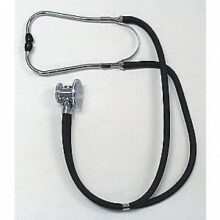Dual Headed Stethoscope
Login For Health Care Pricing
In Stock
A dual head stethoscope allows you to listen to both high and low frequency sounds, using the bell for low frequencies and the diaphragm higher ones.
Stethoscopes are indispensable tools in sports medicine that allow healthcare professionals to listen to athletes’ hearts and lungs, providing valuable information about cardiovascular and respiratory health.
These instruments play a critical role in assessing cardiac and pulmonary function, detecting abnormalities, and optimizing athletic performance. Stethoscopes enable healthcare professionals to hear subtle sounds that can indicate potential issues or guide interventions.
In this article, we explore the uses of stethoscopes in sports medicine and their significance in listening to athletes’ hearts and lungs for optimal performance.
Stethoscopes are primarily used to assess the heart’s function in athletes. By listening to the heart sounds, healthcare professionals can evaluate heart rate, rhythm, and any abnormal cardiac sounds.
This allows for the detection of heart murmurs, irregular heartbeats, or other abnormalities that may impact an athlete’s cardiovascular health and performance.
Stethoscopes are instrumental in assessing cardiac fitness, detecting potential structural abnormalities, and identifying signs of cardiac stress or fatigue. The ability to auscultate the heart provides valuable information for diagnosing cardiovascular conditions and guiding appropriate interventions.
Stethoscopes are also utilized to assess the lungs and respiratory function in athletes.
By listening to lung sounds, healthcare professionals can evaluate respiratory rate, depth, and the presence of abnormal sounds such as wheezing, crackles, or diminished breath sounds. These findings can help detect respiratory conditions such as asthma, bronchitis, or pulmonary infections that may affect an athlete’s breathing capacity and exercise tolerance.
Stethoscopes aid in the identification of abnormalities or limitations in pulmonary function, guiding interventions to optimize respiratory health and performance.
Stethoscopes are used during exercise to evaluate cardiovascular and respiratory responses in athletes. By auscultating the heart and lungs during different exercise intensities, healthcare professionals can assess the athlete’s physiological adaptation and determine if any abnormalities arise during exertion.
This dynamic assessment allows for the identification of exercise-induced arrhythmias, murmurs, or abnormal lung sounds that may not be present at rest.
Monitoring cardiac and pulmonary sounds during exercise provides valuable information to guide exercise prescriptions, detect exercise-induced issues, and optimize athletic performance.
Stethoscopes are vital tools in pre-participation screening for athletes. During pre-participation physical examinations, healthcare professionals use stethoscopes to listen to athletes’ hearts and lungs to assess their overall cardiovascular and respiratory health.
This evaluation helps identify underlying conditions or abnormalities that may predispose athletes to cardiovascular events or respiratory complications during physical activity.
Stethoscope assessments during pre-participation screening ensure that athletes are medically cleared for safe participation in their chosen sport.
Stethoscopes play a role in monitoring recovery and rehabilitation in athletes. By listening to cardiac and pulmonary sounds, healthcare professionals can assess the progress of recovery following cardiovascular or respiratory-related injuries or illnesses.
Monitoring changes in heart and lung sounds helps track improvements, detect complications, and guide the timing and intensity of rehabilitation programs.
Stethoscopes aid in assessing an athlete’s readiness to return to sport and ensure that recovery is progressing optimally.
Stethoscopes are vital tools in sports medicine, allowing healthcare professionals to listen to athletes’ hearts and lungs for optimal performance. These instruments provide valuable information about cardiac and pulmonary function, enabling the assessment of cardiovascular fitness, detection of abnormalities, and guidance for interventions.
Stethoscopes contribute to pre-participation screening, dynamic evaluation during exercise, and monitoring recovery and rehabilitation. The use of stethoscopes enhances the accuracy of cardiovascular and respiratory assessments, promotes athlete safety and helps optimize performance.

Login For Health Care Pricing
In Stock
A dual head stethoscope allows you to listen to both high and low frequency sounds, using the bell for low frequencies and the diaphragm higher ones.

Login For Health Care Pricing
Typically Ships in 3-5 Business Days
The Littman Lightweight Stethoscope provides optimal sound quality at an affordable price

Login For Health Care Pricing
Typically Ships in 3-5 Business Days
The Sprague Rappaport Stethoscope is a dual head stethoscope used to listen to internal sounds on the body, both human and animal.